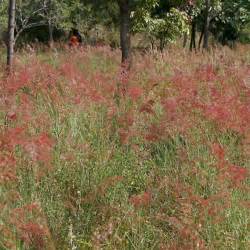EDRR Invasive Species
Natal grass (Melinis repens)
Define Invasive Species: must have ALL of the following –
- Is non-native to the area, in our case northwest Florida
- Introduced by humans, whether intentional or accidental
- Causing either an environmental or economic problem, possibly both
Define EDRR Species: Early Detection Rapid Response. These are species that are either –
- Not currently in the area, in our case the Six Rivers CISMA, but a potential threat
- In the area but in small numbers and could be eradicated
Native Range:
South Africa
Introduction:
Intentionally introduced as a forage plant but lacks the nutritional value of other introduced forage plants.
EDDMapS currently list 3,923 records of this plant, all are across the southern United States from California to Florida. 3,591 reports are from Florida itself, with 53 of these in the Florida panhandle, and 31 of those within Six Rivers CISMA.
Description:
This reddish colored grass can cover large areas of open fields. The reddish color comes from the hair-like structures that are associated with the flowers and will become gray with age. The flowers themselves are a pink-purple in color and are produced from panicles (a cluster of small flowers) that are 4-8 inches long. The grass can reach a height of 40 inches and dispersal is by wind blown seeds.
Issues and Impacts:
It aggressively grows in open fields and displaces native grass species from these areas. Many of which are important to local ecology.
Management:
Hand removal of small patches can be effective, but the property owner should be aware of the ease of seed dispersal when doing this, it is recommended to remove prior to going to seed. It tends to quickly invade open areas of disturbance including the use of fire. Mowing does not provide control.
The herbicides glyphosate and imazapyr have shown to have good control but must be used prior to going to seed. Both herbicides are non-selective, and care must be taken not to treat native plants. Imazapyr has a longer soil life and replanting the area after treatment may not be effective for several months.
There are no known biological controls at this time.
If you are in the Florida panhandle area and believe you may have natal grass, please contact your county extension office to let them know as well as report the siting to www.EDDMapS.org. If you have questions on how to do this, your county extension office can help.
For more information on this EDRR species, contact your local extension office.
References
University of Florida IFAS Center for Aquatic and Invasive Plants. Natal Grass. https://plants.ifas.ufl.edu/plant-directory/melinis-repens/.
Early Detection and Distribution Mapping System (EDDMapS)
Six Rivers CISMA
https://www.floridainvasives.org/sixrivers/
- Rattlesnakes on Our Barrier Islands; Part 3 – Envenomation - December 22, 2025
- St. Joe Red Tide Claiming Terrapins - December 15, 2025
- The 2025 Snake Watch Report for the Pensacola Bay Area - December 15, 2025

